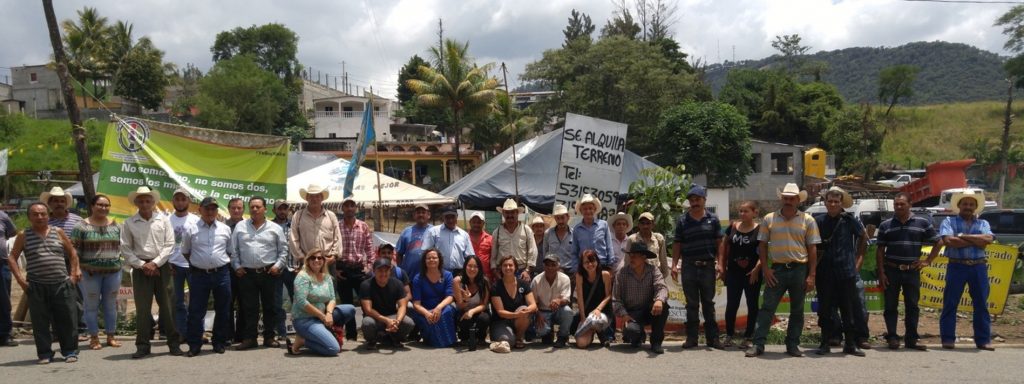Seeds of Truth: Together We Can Accomplish Great Things

As part of the Canadian-Guatemalan Blanket Exercise Youth Exchange, I’ve spent the past 7 days learning from Indigenous leaders in Guatemala about their lived experiences. They have helped me to better understand the human rights violations that have occurred, and continue to occur here. It is a hard and violent history to learn, and the injustice that is still ongoing today is staggering.
The resistance and resilience of Indigenous people here is astounding, and this blog is about one example of the resistance that is being led by Indigenous people.
Yesterday we had the privilege of witnessing resistance to a mine in the community of San Rafael in the south of Guatemala. The resistance is in response to a Canadian mining company, Tahoe Resources, which started building a mine in this community in 2013 without the free, prior and informed consent of the Indigenous groups. It is a tunnel mine, boring into the mountain for silver and many other minerals. Before the mine came into the community, there was a strong coffee industry, farmers and agricultural workers were able to get fair prices for the crops, and the water was pristine. But over the past 5 years, things have changed dramatically. Local farmers are unable to sell their produce at a fair price because people believe that it is has been contaminated by the mine, and that the coffee has diseases.
This area is in the dry corridor of Guatemala, and the mine has not only polluted the water (both lead and arsenic have been found), but also lowered the water table by more than 50%. The mine has also caused huge divisions between families and communities. Folks who are part of the resistance to the mine are criminalized, shot-at, beaten, detained and in some cases killed. Earthquakes caused by mine drilling have forced 110 families to leave their community permanently. It is a terrible and yet familiar story of colonization, destruction, and power. And it is important to understand that we, as Canadians, hold responsibility for the ongoing colonization of this land.

In June of this year there were a few shifts that hold the promise for change. Once again, the resistance gathered together in a permanent camp to form a check-point to stop any vehicles related to the mine from getting through. This is the camp that we visited yesterday. It is a peaceful checkpoint that lets cars and small vehicles pass freely and that stops only large trucks to see if they are related to the mine. In June, the Xinca Parliament, an elected council representing the Indigenous Xinca people in this area, submitted an official complaint to the Supreme Court saying that they were not consulted about this mine. This resulted in a decision by the Supreme Court to suspend the license of the mine, effectively halting all work indefinitely. This was a huge victory for the resistance, and the result of many people working very hard for many years.
Yet, the company still tried to continue working on the mine and in that same month attempted to get a vehicle through the check point in the middle of the night. When they were refused access to the site, the mining company workers used tear gas and beat the defenders of the land. Instead of being intimidated by the attack, a thousand people from the resistance gathered at the check point and the company has not tried to come through the since.
These recent events are certainly promising, yet the fight for justice is far from over. Tahoe Resources is suing the government for financial losses accrued due to the mine suspension over the past few months, and at any point the court could lift its suspension of the mine. The resistance is calling for a complete closure of the mine, and a moratorium on any more licences in the area.
This is a familiar story to North America as well. I think about how the Indigenous resistance at Standing Rock was criminalized, detained, and assaulted. I think about how Indigenous communities that are next to big mines are often the poorest, like Attawapiskat. I think of the catastrophic environmental destruction that affects communities and destroys watersheds around mining development, like the Mt Polley mine disaster in central BC in 2015. I think of the present and ongoing resistance and resilience of Indigenous people who dedicate their lives to protecting their land and their water, like the Shubenacadie River resistance in Nova Scotia.
I will leave you with something that the leaders of the Xinca people said to us (via translation): “Sometimes we feel like we are ants fighting against a giant. But when we come together and we fight with a unified voice, we can accomplish great things.” He was very hopeful when he said these words to us, a remarkable feeling given the place of struggle and pain and hardship that he is coming from. I find it strengthening to see his strong resistance and resilience, and it motivates me to find those same qualities in myself so that I can play my part in working for justice.
Hannah Gehrels is a settler youth living in Charlottetown and a participant in the Seeds of Truth KAIROS Blanket Exercise Youth Exchange with Guatemala.







